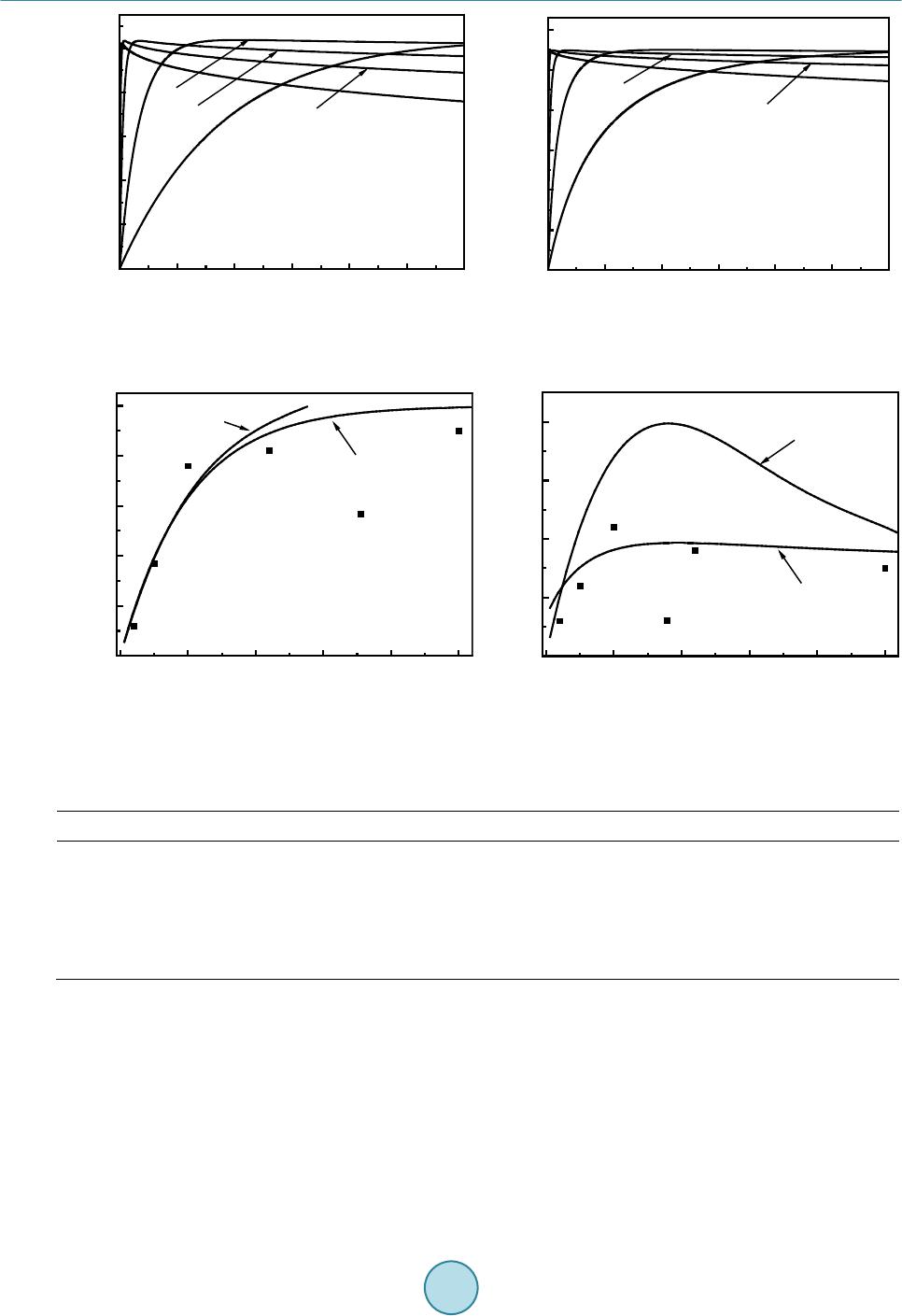 Journal of Power and Energy Engineering, 2015, 3, 56-62 Published Online April 2015 in SciRes. http://www.scirp.org/journal/jpee http://dx.doi.org/10.4236/jpee.2015.34009 How to cite this paper: Liu, Y. and Yang, Y.P. ( 2015) Evolution of the Surface Area of Limestone during Calcination and Sin- tering. Journal of Power and Energy Engineering, 3, 56-62. http://dx.doi.org/10.4236/jpee.2015.34009 Evolution of the Surface Area of Limestone during Calcination and Sintering Yang Liu, Yongping Yang School of Energy Power and Mechanical Engineering, North China Electric Power University, Beijing, China Email: hdliuyang@163.com Received Dec emb er 2014 Abstract The calcination reaction of limestone is always companied by sintering of the calcined product. In addition, accelerated sintering rates and a reduced specific surface area are observed in the pres- ence of steam and carbon dioxide. To simulate the change of surface area and the porosity of li- mestone samples in a sim ultaneous calcination and sintering process, a combined model based on both a sintering model and a calcination model is established. The calcination model, which pre- dicts calcination conversion as a function of time, is based on the initial properties of the sorbent. The sintering model is according to the German and Munir model in which the main transport mechanism is supposed to be lattice diffusion. In a flow reactor, the surface area value and calci- nation rate of limestone in the presence of steam and CO2 are als o described by the combined model with modified paramete rs. Keywords Calcinatio n, Sintering, Limestone, Combined Model 1. Introduction Sintering refers to the changes in pore shape, pore shrinkage and the increase in grain size that CaO particles under go during heating. The rate of CaO sintering increases at higher temperatures, as well as at higher partial pressures of carbon dioxide and steam vapor. The presence of impurities also increases the sintering rate. In general, hi gher temperatures are required to increase reaction rates, but because of the sinterin g process, the structure of the calcine is more likely to change. Beruto et al. [1] found that the surface area of CaO produced from calcite crystals is constant at 116 m2/g when the calcite crystals are decomposed under vacuum at 686˚C. The volume occupied by a CaO aggregate is 98% that of the original calcite crystal. Powell and Searcy [2] also obtained the same surface area value for CaO in another apparatus with good evacuation. Furt hermore, Beruto et al. [3] noticed the influence of CO2 pressure on sintering when they measured a surface area of 89 m2/g CaO from the decomposition of large crystals of cal- cite at 580˚C when the evacuation was less complete because of low vacuum pump speed. Large particles of limestone calcinated in a rotary kiln at 980˚C normally resulted in surface areas of only 2 to 5 m2/g. Chan et al. [4] attained a surface area of 24.6 m2/g by calcining limestone particles in a TGA at 745˚C.  Y. Liu, Y. P. Yang Fennell et al. [5] obtained the largest surface area of 39 m2/g at 1023 K in the study of the effect of repeated cycles on sorbent activity. Sun et al. [6] also found a surface area of 36 m2/g using Strassburg limestone in a TGA at 850˚C. The TGA generally employed for these studies is limited to samples with a relative large particle density due to poor dispersion in the sample holder. The low gas throughput of the sample imposes another se- vere limitation because it aggravates the effect of CO2 on sintering. There exists evidence that the sintering mechanism of CaO is fundamentally related to the mass transport. Borgwardt et al. [7] noticed that the product layer diffusivities for the sulfation of CaO of varying purity show higher values when the CaO is de rive d from limestones than when it comes from pure CaCO3. Further more, the addition of small amounts of certain salts is found to enhance sulfation especially when added to presintered CaO. The ions in these salts, such as Li+, Na+, Cr3+ and Mo3+, when incorporated into a CaO lattice, produce de- fects that promote solid state diffusion. Similar effects of these foreign ions are observed on the sintering of CaO. By comparing the result of the CO2 looping cycle performance of a limestone, Manovic et al. [8] believed that the presence of Na ions increases the diffusion of Ca ions and that this enhanced diffusion accelerates the gas- solid reaction. From SEM images, Manovic et al. also observed the pronounced sintering and the loss of surface area as a result of the presence of Na ions in the CaO powder. As a result, Borgwardt et al. [9] found that the ac- tivation energy for the sintering of pure CaO is greater than that fo r the impure material. Therefore, the observed effects are consistent with the hypothesis that diffusion through the product layer occurs by ionic transport and that the mechanism of sintering is related to the mechanism of product layer diffusion. This paper describes a combined model, based on a sintering model from German and Munir [10] and a first-order calcination model from Borgwardt [11]. Supposing that the surface area of limestone varies linearly with the mole fraction of CaO in the sample in the absence of sintering, the simulation results during simultane- ous calcination and sintering are shown at various reaction temperatures. In the presence of steam and CO2, the German-Munir model is also used to simulate an isothermal sintering process. The combined model is beneficial to the under sta ndi ng of the diffusion mechanism in calcination and sintering reaction with or without a catalyzed atmosphere. 2. Model Description 2.1. Calcination and Sintering Model Beruto and Searcy [12] showed that the calcination rate per unit area of a flat crystal surface is constant at a given temperature and calcination rates for limestone have been presented as a first -order Arrhenius expression, thus (1) where wCaCO3 is the mass of the undecomposed calcium carbonate, Kc is the rate constant of the calcination reac- tion, and ACaCO3 is the surface area of the calcium carbonate. Assuming that the induction period of the calcina- tion can be neglected [13], the calcination rate at time t is proportional to the BET surface area of the undecom- posed CaCO3, thus (2) where sg is the specific BET surface area of limestone per unit mass. The rate expression given by Equatio n (1) can be integrated as: 3 3 1CaCO 10 CaCO dd xt cg wKs t w − = − ∫∫ (3) This yields the following calcination model for small particles: (4) where x is fractional conversion of CaCO3 to CaO. The rate constant for the surface reaction in the Borgwardt [13] model sho wed an independent trend with the type of stone and the particle size from 1 to 90 μm. The equa- tion accurately fits the measured extent of calcination as a function of time. Thus, the model of Borgwardt is uti- lized in the following calculation.  Y. Liu, Y. P. Yang German and Munir [10] proposed a model of the interparticle neck shape during sintering. The following ge- neralized expression is derived for this process: (5) where S0 is the initial specific surface area, S is the specific surface at time t, and Ks is the sintering rate constant. The exponent has unique values for the different transport mechanisms. Using the German-Munir model, Borgwardt [9] compared the rate of the surface area reduction in CaO that was derived from limestone. The ex- pone nt in Equation (5) was estimated by fitting the widest range of values. Values of yielded the best fit with these data. Thus, the model of Borgwardt is utilized in the following calculation. Assuming that the CO2 effect and the sintering of the calcine can be omitted under the differential condition, the surface area during calcination can be expressed as: (6) where Sid is the surface area supposing that no sintering happens, Sk is the surface area constant and Si is the ini- tial surface area of the limestone. According to this model, the CaO product is divided into increments depending on the time interval in which each increment is formed. At the jth time interval, the CaO produced in the ith time interval experienced the sintering time of the j- ith interval. Equation (5) can thus be rewritten as: ( ) ( ) ( ) 1 1 ids ji S SKtt γ =−− (7) where Sid is the initial specific surface area and can be determined according to Equation (6). The surface area of the CaO formed during the ith time interval can be calculated by Equation (7) at the end of the jth time interval. The surface area of the entire product and the overall specific surface area of the calcined particle are calculated as (8) ( )() 3 CaO CaCO ,1 s Sx txSxS= +− (9) where Si,j is the specific surface area of the CaO formed in the ith time interval at the end of the jth time interval, zi is the fraction of the total CaO formed in the ith time interval, SCaO is the specific surface area of the CaO product and SCaCO3 is the specific surface area of the Ca CO3. In a review of much previous research, Milne et al. [14] compared the surface area and porosity measure- ments for carbonate-derived CaO with differing degrees of sintering and varying calcination conditions and found that when the surface area S is plotted against the porosity, a linear regression of many of the data sets passes through the origin. The upper limit of the data is represented by a curve. The empirical formula is utilized in this combined model and the specific surface area along this curve is expressed as: (10 ) Equation (4) is utilized to evaluate the conversion change with time. With Equations (6)-(9), the value of S is determined. The resultant porosity is determined with Equati on (10). 2.2. Sintering Model in the Presence of Steam and CO2 The sintering process that occurs in N2 can be described with two parameters of Ks and , one temperature de- pendent and the other mechanism dependent. In true flue gas, both steam and CO2 accelerate the CaO sintering. Anderson et al. [15] found that the surface reduction of CaO is sensitive to water vapor and that the reduction is due to crystallite growth, not merely agglomeration and closure of pores. Beruto et al. [16] showed the catalytic effect of CO2 by measurements of the surface area and porosity reduction in CaO below the equilibrium pressure of CaCO3 decomposition. In the presence of steam and CO2, sintering is a process involving multiple transport  Y. Liu, Y. P. Yang mechanisms, so Equation (5) can not be strictly applied. The rate constant K and both change with gas composition and temperature as more than one mechanism becomes effective. Because this is an empiric al ap- proach, the values of K and no longer have significance regarding the sintering mechanism. The experiment results of Borgwardt [17] show that the parameter becomes dependent on temperature and partial pressure in the presence of steam and CO2. The relationships between and the partial pressure of steam or CO2 can separately be expressed as ( ) 22 HO HO ln0.00262ln1.39 11.1TP γ = +− (11) ( ) 22 CO CO ln0.0034ln1.948 44.9TP γ = +− (12) The parameter in presence of steam and CO2 is a function of temperature and the composition of the sin- tering atmosphere and can be expressed as ( ) 222 2 H OCOH OCO 0.376 8.8 γ γγ + = ++ (13) The parameter Ks in atmospheres containing both steam and CO2 is given by 2 CO ln1.485 0.558ln11660 s K PT=+− (14) Combining Equati o ns (11)-(14) with Equation (5), an empirical model for S as a function of time is given. 3. Simulated Results of Models Alt hough there are a large number of calcine-sintering experiments, work on the simultaneous calcination and sintering process under the differential condition is scarce. In this paper, the rate constant Kc for the surface reaction in the calcination model is first determined by the experimental data from the flow reactor with 10 μm Fredonia limestone [13]. Second, the sintering rate constant Ks in the sintering model is acquired usin g the sur- face-area reduction curve in a particle size range of 2 to 20 μm using the same Fredonia limestone [9] because the effect of particle size on the sintering rate in this range can be omitted. The BET surface area of 10 μm Fre- donia limestone is 0.86 m2/g. The calcination and sintering activation energies are calculated separately by the rate constant point at the temperature range indicated. It should be noted that the surface area constant (Sk) must be determined accurately and uncertainties in Sk will significantly influence the surface area calculated. Because sintering occurs even at low temperatures during the calcin ation process, the value can not be obtained by BET measurement. Fredonia limestone with a particle diameter of 10 μm were calcined in the differential reactor at 700˚C and a mean value of 104 m2/g was used for all calculations involving the Ca CO3 der ivat i ve [9]. Thus, the surface area constant calculated by the combined model at 700˚C is 107 m2/g and this surface area constant is utilized in the combined model at various calcination temperatures. Supposing that the calcination reaction of Fredonia limestone is performed at 700˚C - 1000˚C, the predictions of the model at various reaction tempera- tures with a particle diameter of 10 μm is shown in Figure 1 and the combined model parameters and the si mu- lated results are listed in Table 1. According to the calculation results of the combined model, the uppermost value of 104.2 m2/g happened at 114.7 second for Fredonia limestone calcinated at 700˚C. Even one minute later, the value of the surface area heated at 700˚C is more than 104 m2/g. The change in surface area after the calcination reaction is not signifi- cant, which is the reason that Borgwardt prepared the precalcined limestone sample at 700˚C. When the calcina- tion temperature is increased from 700˚C to 1000˚C, the period of complete calcination is reduced from 114.7 sec to 0.4 sec, wh ich is shown in Table 1. However, the maximum surface area under various calcination tem- peratures does not change much before the temperature effect on sintering becomes sign ifi ca nt in the ensuing period. Figure 1 also shows that increasing the reaction temperature enhances the calcination rate and the si n- tering rate, which causes the surface area and the porosity of a limestone sample calcined at 1000˚C to decrease to values of 78 m2/g and 0.45, respectively, after a 60 sec reaction time. In Figure 2, the calcination rate and surface area data reported by Bortz et al. [18] of 13 μm Marianna limes- tone calcined in a flow reactor at 1373 K are compared with the prediction of the model in the presence of steam and CO2. Because the initial surface area of Marianna limestone is not provided in the work of Bortz, the BET surface area of 0.86 m2/g is assumed in this model. The parameter of Kc is obtained fro m the calcination rate in Figure 2(a). The partial pressures of CO2 and steam in the flue gas atmosphere are 7.5 kPa and 14 kPa, respec-  Y. Liu, Y. P. Yang Figure 1. The effect of simultaneous calcination and sintering under various reaction temperatures on (a) specific surface area, and (b) porosity. Figure 2. Model prediction for 13 μm Marianna limestone calcined at 1373 K in a flow reactor [18], (a) Extent of calcination, and (b) Surface area. Table 1. Model parameters and simulated results. T (˚C) Kc (g/m2∙min ) Ks (1/t) SMax (m2/g) t (Sec) 700 3.8 0.000027 104.2 114.7 775 20.5 0.00024 103.7 20.8 860 120.5 0.002 103.3 3.5 925 500.5 0.0084 103.3 0.8 1000 1000.5 0.036 102.2 0.4 tively. The parameters and Ks, calculated with Equatio n (13) and Equation (14), are 45 and 0.02, respective- ly. Figure 2(b) shows a comparison between the predictions of the Milne model [14] and that of the model in this paper. Milne applied an empirical surface area expression to reflect the influence of steam and CO2 and a prior knowledge of the asymptotic surface area as a function of temperature should be required. The sintering model of this paper in the presence of steam and CO2 utilizes only the German-Munir model and the parameters of and Ks are obtained only according to the simulation formula provide by Borgwardt [17]. The model pre- diction is closer to the actual surface area of the 13 μm Marianna limestone. The experimental result and model simulation show that the surface area reduction is accelerated in the presence of steam and CO2. The sintering activation energy in the presence of steam and CO2 is 97 kJ/mol, calculated wit h the diffusion coefficient Ks, 010 20 30 40 50 60 0 20 40 60 80 100 1000 o C 925 o C 860 o C 775 o C Specific surface area (m 2 /g) Time (sec) 700 o C (a) 010 2030 40 5060 0.0 0.1 0.2 0.3 0.4 0.5 0.6 (b) Porosity Time (sec) 775 o C 700 o C 860 o C 925 o C 1000 o C 0.0 0.1 0.2 0.30.4 0.5 0.0 0.2 0.4 0.6 0.8 1.0 Model prediction of Milne Extent of calcination Time (sec) Exp. result (a) Model prediction 0.0 0.1 0.2 0.30.4 0.5 0 10 20 30 40 (b) Exp. result Surface area (m2/g) Time (sec) Model prediction of Milne Model prediction  Y. Liu, Y. P. Yang which is much less than the sintering activation energy in N2. The increased sintering rate caused by steam and CO2 is in accord with the expected effect of surface diffusion and grain boundary diffusion. Relative to the sin- tering rate of lattice diffusion, these two diffusions reduce the apparent sintering activation energy and increase the diffusivity. According to the combined model, at 1100˚C the surface area of Fredonia limestone produces the maximum observed value of 102.2 m2/g at 0.08 sec in N2. However, the result of the model in the presence of steam and CO2 suggests an approximate peak surface area of 18.5 m2/g at 0.15 sec, which is shown in Figure 2(b). A shift of the primary sintering mechanism from slow lattice diffusion to the faster mechanism would agree with the effects apparent from this comparison. 4. Conclusion The German-Munir model not only can be used to correlate the kinetics of the CaO surface area reduction in in- ert atmospheres but also can be modified to empirically account for the effects of steam and CO2. The surface area value and porosity of limestone samples in simultaneo us calcination and sintering process is determined by a combined model. The surface area reduction during sintering suggests that besides lattice diffusion both sur- face diffusion and grain boundary mechanisms are more evident in the presence of steam and CO2. Acknowledgements This research was supported by the National Natural Science Foundation of China (No. 51025624), the 111 project (B12034) and the Fundamental Research Funds for the Central Universities (2014QN08). The author is grateful for the supporting of Australia-China JCG Round 2 Partnership Funding. References [1] Beruto, D., Barco, L. and Searcy, A.W. (1983) Rearrangement of Porous CaO Aggregates during Calcite Decomposi- tion in Vacuum. Journal of the American Ceramic Society, 66, 893-896. http://dx.doi.org/10.1111/j.1151-2916.1983.tb11008.x [2] Powell, E.K. and Searcy, A.W. (1982) Surface Areas and Morphologies of CaO Produced by Decomposition of Large CaCO3 Crystals in Vacu um. Journal of the American Ceramic Society, 65, C42-C44. http://dx.doi.org/10.1111/j.1151-2916.1982.tb10395.x [3] Beruto, D., Barco, L., et al. (1980 ) Characterization of the Porous CaO Particles Formed by Decomposition of CaCO3 and Ca(OH)2 in Vacuum. Journal of the American Ceramic Society, 63, 439-443. http://dx.doi.org/10.1111/j.1151-2916.1980.tb10208.x [4] Chan, R.K., Murthi, K.S. and Harriso n, D. (1970 ) Thermogravimetric Analysis of Ontario Limestone and Dolomites. 1. Calcination, Surface Area and Porosity. Canadian Journal of Chemistry, 48, 2972-2978. http://dx.doi.org/10.1139/v70-503 [5] Fennell, P.S., Pacciani, R., et al. (2007) The Effects of Repeated Cycles of Calcination and Carbonation on a Variety of Different Limestones, as Measured in a Hot Fluidized Bed of S and. Energy Fuels, 21 , 2072-2081. http://dx.doi.org/10.1021/ef060506o [6] Sun, P., Grace, J.R., et al. (2 007) The Effect of CaO Sintering on Cyclic CO2 Capture in Energy Systems. AIChE Journal, 53, 2432-2442 . http://dx.doi.org/10.1002/aic.11251 [7] Borgwardt, R.H., Br uce, K.R., et al. (1987) An Investigation of Product-Layer Diffusivity for CaO Sulfation. In d ustri- al & Engineeri ng Chem ist ry Research , 26, 1993-1998 . http://dx.doi.org/10.1021/ie00070a010 [8] Manovic, V., Anthony, E.J., et al. (2008) CO2 Looping Cycle Performance of a Hi gh-Purity Limestone after Thermal Activation/Doping. Energy Fuels, 22, 3258-32 64. http://dx.doi.org/10.1021/ef800316h [9] Borgwardt, R.H. (1989) Sintering of Nascent Calcium-Oxide. Chemical Engineering Science, 44 , 53-60. http://dx.doi.org/10.1016/0009-2509(89)85232-7 [10] German, R.M. and Munir, Z.A. (1976) Su rface-Area Reduction during Isothermal Sintering. Journal of the American Ceramic Society, 59, 379-38 3. http://dx.doi.org/10.1111/j.1151-2916.1976.tb09500.x [11] Borgwardt, R.H. and Bruce, K.R. (1986) Effect of Specific Surface Area on the Reactivity of CaO with SO2. AIChE Journal, 32, 239-246. http:// dx.d oi. or g/10 .10 02 /ai c.69 0320 21 0 [12] Beruto, D. and Searcy, A. W. (1974) Use of the Langmuir Method for Kinetic Studies of Decomposition Reactions: Calcite (CaCO3). Journal of the Chemical Society, Faraday Transactions 1: Physical Chemistry in Condensed Phases, 70, 2145-2153. http://dx.doi.org/10.1039/f19747002145  Y. Liu, Y. P. Yang [13] Borgwardt, R.H. (1985) Calcination Kinetics and Surface-Area of Dispersed Limestone Particles. AIChE Journal, 31, 103-111. http://dx.doi.org/10.1002/aic.690310112 [14] Milne, C.R., Silcox, G. D., et al. (1990) Calcination and Sintering Models for Application to High -Temperatu re, Sho rt - Time Sulfation of C alcium-Based Sorbents. Indu strial & Engin eering Ch e m istry R esearch , 29, 139-149. http://dx.doi.org/10.1021/ie00098a001 [15] Anderson, P.J., Horlock, R.F., et al. (1965) Some Effects of Water Vapour during the Preparation and Calcination of Oxide Powders. Proc. Br. Ceram. Soc, 3, 33. [16] Beruto, D., Barco, L. , et al. (1984 ) CO2-Catalyzed Surface-Area and Porosity Changes in Hi gh-S u rfa c e-Area CaO Ag- gregates. Journal of the American Ceramic Society, 67, 512-515. http://dx.doi.org/10.1111/j.1151-2916.1984.tb19644.x [17] Borgwardt, R.H. (19 89 ) Calcium-Oxide Sintering in Atmospheres Containing Water and Carbon-Dioxide. In d ust rial & Engineerin g Ch e mi stry Research , 28, 493-500. http://dx.doi.org/10.1021/ie00088a019 [18] Bortz, S.T., Roman, V.P., et al. (1986) Precalcination and Its Effect on Sorbent Utilization during Upper Furnace In- jection. Notation ACaCO3 Surface area of calcium carbonate, m2 Kc Rate constant for surface area, g/m2∙min Ks Sintering rate constant in an inert atmosphere, t−1 S Specific surface area at time t, m2/g S0 Initial specific surface area of CaO following decomposition of its precursor, m2/g SCaO Specific surface area of CaO product, m2/g SCaCO3 Specific surface area of CaCO3, m2/g Sk Surface area constant without the CO2 effect on sintering, m2/g Si Initial surface area of limestone, m2/g Sid Surface area supposing that no sintering happens, m2/g Si,j Specific surface area of CaO formed in the ith time interval at the end of the jth time interval, m2/g Ss Overall specific surface area of the particle, m2/g sg Specific BET surface area of limestone, m2/g t Tim e ti ith time interval tj jth time interval wCaCO3 Undecomposed calcium carbonate in sample, g x Fractional conversion of CaCO3 to CaO zi Fraction of total CaO formed in the ith time interval Greek letters γ Mechanism-dependent exponent γCO2 Mechanism-dependent exponent in atmosphere of N2 containing CO2 γH2O Mechanism-dependent exponent in atmosphere of N2 containing H2O γH2O + CO2 Mechanism-dependent exponent in atmosphere of N2 containing H2O and CO2 ε Porosity of sample
|